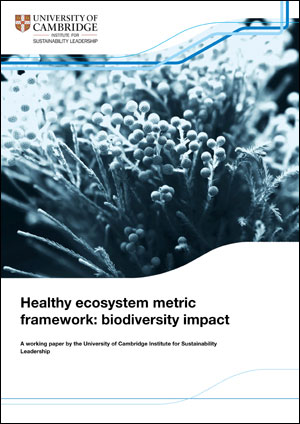May 2017 – Investors and companies want to demonstrate their positive impacts on natural capital and show they are reversing the trend of natural environment degradation. The challenge is to identify metrics that are relevant for businesses’ decision-making processes, whilst being simple and practical for investors to use. This working paper outlines the concept for such metrics as developed by members of the Natural Capital Impact Group. It explores how the metric can be categorised as impacts upon the quality and quantity of soil, water and biodiversity. The paper explains the simple methodology that can be applied for business to calculate their impacts consistently and comparably, focusing particularly on the biodiversity component of this metric (soil and water components will be described in separate papers).
Publication date
May 2017
Abstract
Investors and companies alike want to create long-term value by mitigating risks and improving their impact on the natural environment. Company productivity is dependent upon a resilient environment and reducing impacts is beneficial to both nature and business. Opportunities exist for investors and companies to demonstrate positive impacts and show they are reversing the trend of natural environment degradation. The challenge is to identify metrics that are relevant for businesses’ decision making process, whilst being simple and practical for investors to use.
To date, many initiatives have developed a series of metrics related to natural capital. The uptake of measures and approaches to natural capital is growing within corporate contexts, especially with the release of the Natural Capital Protocol and with leaders such as Kering who have shared their Environmental Profit and Loss (EP&L) methodology.
A need has been identified for a single impact metric which is simple and influential to decision making across corporates and investors. This working paper is the first step towards a proof of concept for such a metric; it builds upon existing approaches and guidance with the aim of providing consistent, context based metrics that can support corporate decision making and demonstrate positive impacts. The next step is to test it with companies and investors in real business contexts.
Members of the Natural Capital Leaders Platform and Investment Leaders Group came together with other experts in academia, corporate sustainability and biodiversity conservation to co-develop metrics that are influential in decision making, practical to use and meaningful across the value chain. The metric development builds upon work from the Investment Leaders Group on measuring impact and the Natural Capital Leaders Platform’s advances on biodiversity metrics, while remaining relevant across business sectors and other players in the value chain. It was agreed to co-develop a composite ‘healthy ecosystem’ metric, with sub-components of biodiversity, soil and water. Key to the development of the different components of the Healthy Ecosystem framework has been the active engagement, pilot testing and financing by leading companies and members of the Natural Capital Impact Group. As such, Kering has supported the development of the Biodiversity Indicator and leveraged their Environmental Profit and Loss (EP&L) methodology while other members of the group have focused upon understanding the categorisation of, for example, healthy soil.
The metric proposed is based on the impact of a company upon the quality and quantity of biodiversity, soil and water. This paper details how this metric is constructed and provides insight into the biodiversity sub-component.
Authors
Dr Martina Di Fonzo, Postdoctoral Researcher, CISL and Dr Gemma Cranston, Acting Director, Natural Resource Security Portfolio, CISL
Citation
Di Fonzo, M. & Cranston, G., (2017), ‘Healthy Ecosystem metric framework: Biodiversity impact, University of Cambridge Institute for Sustainability Leadership (CISL), Working Paper 02/2017




